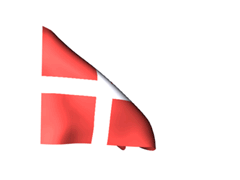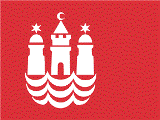 The Danish flag, also called Danneborg ("Danish cloth" in Danish), consists of a red background and white cross which extends to the edges of the flag. The vertical arm of the cross follows the model of the other Scandinavian flag thus it is located closer to the left side of the flag. According to the legend, the flag was sent down from heaven in order to help the Danish army on June 15, 1219 during the Battle of Lyndanise. King Valdemar II. would nearly lose the battle against the pagan Estonians, if there was not a sign from heaven that gave the army new energy that helped them to win the battle. The flag is also used in a little bit modified version as a naval flag - it is square and it has two little flags similar to swallowtail.
The Danish flag, also called Danneborg ("Danish cloth" in Danish), consists of a red background and white cross which extends to the edges of the flag. The vertical arm of the cross follows the model of the other Scandinavian flag thus it is located closer to the left side of the flag. According to the legend, the flag was sent down from heaven in order to help the Danish army on June 15, 1219 during the Battle of Lyndanise. King Valdemar II. would nearly lose the battle against the pagan Estonians, if there was not a sign from heaven that gave the army new energy that helped them to win the battle. The flag is also used in a little bit modified version as a naval flag - it is square and it has two little flags similar to swallowtail.
 Peter Orenski wrote, "As passionate vexillologists, once we found out that Copenhagen didn't have a city flag, we went to Town Hall and spoke with people in the Archive Dept., Library, and Jan Horskjœr's Information Office, trying to find out: (1) WHY Copenhagen didn't have a flag, and
(2) WHAT the various Copenhageners at Town Hall thought an appropriate symbol and flag for the capital might be. The Archive Dept. and Mr. Horskjœr's office were especially helpful in providing copies of the Københavns Kommune's beautiful arms, both the original design and its modern stylized version. After several discussions with Town Hall employees, they agreed that the attached design would be an appropriate city flag. As you see, the proposed flag mirrors the national flag in its dimensions, colors, and hoist-displaced charge -- Bishop Absalon's famous 1167 'Castle at Havn.'
Peter Orenski wrote, "As passionate vexillologists, once we found out that Copenhagen didn't have a city flag, we went to Town Hall and spoke with people in the Archive Dept., Library, and Jan Horskjœr's Information Office, trying to find out: (1) WHY Copenhagen didn't have a flag, and
(2) WHAT the various Copenhageners at Town Hall thought an appropriate symbol and flag for the capital might be. The Archive Dept. and Mr. Horskjœr's office were especially helpful in providing copies of the Københavns Kommune's beautiful arms, both the original design and its modern stylized version. After several discussions with Town Hall employees, they agreed that the attached design would be an appropriate city flag. As you see, the proposed flag mirrors the national flag in its dimensions, colors, and hoist-displaced charge -- Bishop Absalon's famous 1167 'Castle at Havn.'
To return to the main listing of the cruise hyperlinks click here
 The Danish flag, also called Danneborg ("Danish cloth" in Danish), consists of a red background and white cross which extends to the edges of the flag. The vertical arm of the cross follows the model of the other Scandinavian flag thus it is located closer to the left side of the flag. According to the legend, the flag was sent down from heaven in order to help the Danish army on June 15, 1219 during the Battle of Lyndanise. King Valdemar II. would nearly lose the battle against the pagan Estonians, if there was not a sign from heaven that gave the army new energy that helped them to win the battle. The flag is also used in a little bit modified version as a naval flag - it is square and it has two little flags similar to swallowtail.
The Danish flag, also called Danneborg ("Danish cloth" in Danish), consists of a red background and white cross which extends to the edges of the flag. The vertical arm of the cross follows the model of the other Scandinavian flag thus it is located closer to the left side of the flag. According to the legend, the flag was sent down from heaven in order to help the Danish army on June 15, 1219 during the Battle of Lyndanise. King Valdemar II. would nearly lose the battle against the pagan Estonians, if there was not a sign from heaven that gave the army new energy that helped them to win the battle. The flag is also used in a little bit modified version as a naval flag - it is square and it has two little flags similar to swallowtail. Peter Orenski wrote, "As passionate vexillologists, once we found out that Copenhagen didn't have a city flag, we went to Town Hall and spoke with people in the Archive Dept., Library, and Jan Horskjœr's Information Office, trying to find out: (1) WHY Copenhagen didn't have a flag, and
(2) WHAT the various Copenhageners at Town Hall thought an appropriate symbol and flag for the capital might be. The Archive Dept. and Mr. Horskjœr's office were especially helpful in providing copies of the Københavns Kommune's beautiful arms, both the original design and its modern stylized version. After several discussions with Town Hall employees, they agreed that the attached design would be an appropriate city flag. As you see, the proposed flag mirrors the national flag in its dimensions, colors, and hoist-displaced charge -- Bishop Absalon's famous 1167 'Castle at Havn.'
Peter Orenski wrote, "As passionate vexillologists, once we found out that Copenhagen didn't have a city flag, we went to Town Hall and spoke with people in the Archive Dept., Library, and Jan Horskjœr's Information Office, trying to find out: (1) WHY Copenhagen didn't have a flag, and
(2) WHAT the various Copenhageners at Town Hall thought an appropriate symbol and flag for the capital might be. The Archive Dept. and Mr. Horskjœr's office were especially helpful in providing copies of the Københavns Kommune's beautiful arms, both the original design and its modern stylized version. After several discussions with Town Hall employees, they agreed that the attached design would be an appropriate city flag. As you see, the proposed flag mirrors the national flag in its dimensions, colors, and hoist-displaced charge -- Bishop Absalon's famous 1167 'Castle at Havn.'